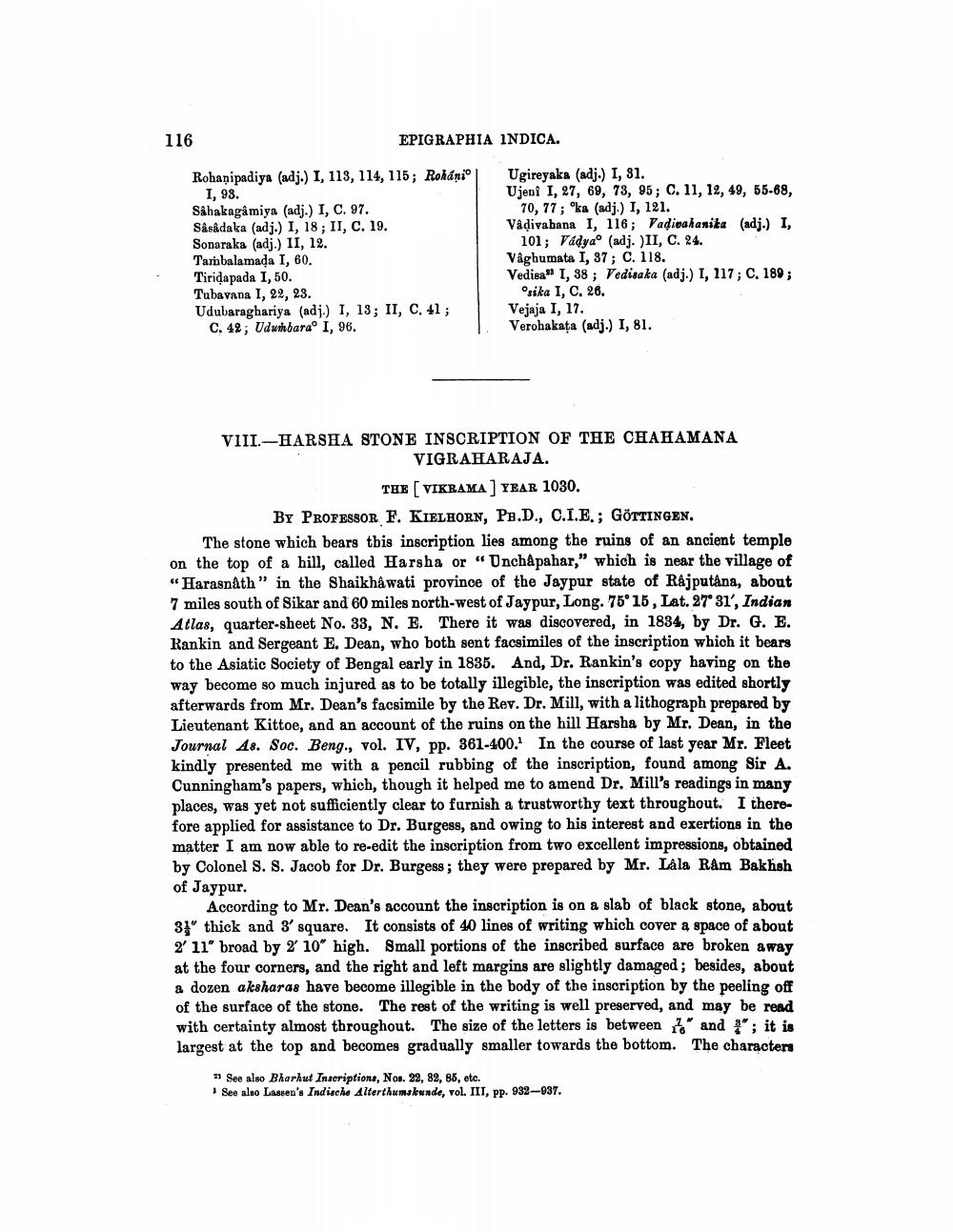________________
116
EPIGRAPHIA INDICA.
Rohanipadiya (adj.) I, 113, 114, 115; Rohário
I, 93. Såhakagamiya (adj.) I, C. 97. Såsådaka (adj.) I, 18; II, C. 19. Sonaraka (adj.) II, 12. Tambalamada I, 60. Tiridapada 1,50. Tubavana 1, 22, 23. Udubaraghariya (adj.) I, 13; II, C. 41;
C. 4% ; dự thi bara° I, 96.
Ugireyaks (adj.) I, 31. Ujeni I, 27, 69, 73, 95; C. 11, 12, 49, 55-68,
70,77 ; oka (adj.) I, 121. Vadivabana I, 116; Vadipakanita (adj.) I,
101; Vádyao (adj.)II, C. 24. Vâghumata I, 37; C. 118. Vedisa" 1, 38; Vedisaka (adj.) I, 117; C. 189;
Osika I, C. 26. Vejaja I, 17. Verohakata (adj.) I, 81.
VIII.-HARSHA STONE INSCRIPTION OF THE CHAHAMANA
VIGRAHARAJA.
THE ( VIKRAMA ] YEAR 1030. BY PROFESSOR F. KIELHORN, PH.D., C.I.E.; GÖTTINGEN. The stone which bears this inscription lies among the ruins of an ancient temple on the top of a hill, called Harsha or “Unchapahar," which is near the village of "Harasnath" in the Shaikhâwati province of the Jaypur state of Rajputana, about 7 miles south of Sikar and 60 miles north-west of Jaypur, Long. 75° 15, Lat. 27° 31', Indian Allas. quarter-sheet No. 33, N. E. There it was discovered, in 1884, by Dr. G. E. Rankin and Sergeant E. Dean, who both sent facsimiles of the inscription which it bears to the Asiatic Society of Bengal early in 1835. And, Dr. Rankin's copy having on the way become so much injured as to be totally illegible, the inscription was edited shortly afterwards from Mr. Dean's facsimile by the Rev. Dr. Mill, with a lithograph prepared by Lieutenant Kittoe, and an account of the ruins on the hill Harsha by Mr. Dean, in the Journal 48. Soc. Beng., vol. IV, pp. 361-400, In the course of last year Mr. Fleet kindly presented me with a pencil rubbing of the inscription, found among Sir A. Cunningham's papers, which, though it helped me to amend Dr. Mill's readings in many places, was yet not sufficiently clear to furnish a trustworthy text throughout. I therefore applied for assistance to Dr. Burgess, and owing to his interest and exertions in the matter I am now able to re-edit the inscription from two excellent impressions, obtained by Colonel S. S. Jacob for Dr. Burgess; they were prepared by Mr. Là la Ram Bakhsh of Jaypur.
According to Mr. Dean's account the inscription is on a slab of black stone, about 3 thick and 3' square. It consists of 40 lines of writing which cover a space of about 2' 11" broad by % 10" high. Small portions of the inscribed surface are broken away at the four corners, and the right and left margins are slightly damaged; besides, about a dozen aksharas have become illegible in the body of the inscription by the peeling off of the surface of the stone. The rest of the writing is well preserved, and may be read with certainty almost throughout. The size of the letters is between " and "; it is largest at the top and becomes gradually smaller towards the bottom. The characters
* See also Bharhut Inscriptions, Nos. 32, 82, 88, etc. See also Lussen's Indische Alterthumskunde, vol. III, pp. 932-937.




